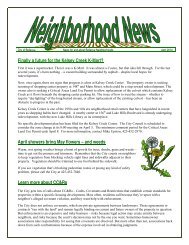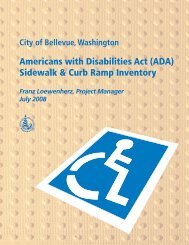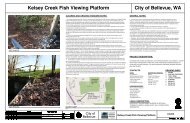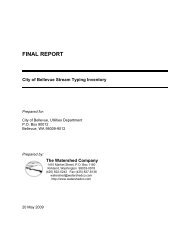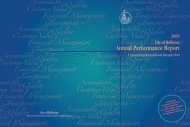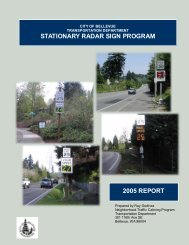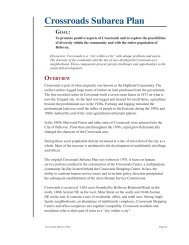Inspection and Installation Compliance Checklists
Inspection and Installation Compliance Checklists
Inspection and Installation Compliance Checklists
- No tags were found...
Create successful ePaper yourself
Turn your PDF publications into a flip-book with our unique Google optimized e-Paper software.
<strong>Inspection</strong> <strong>and</strong> <strong>Installation</strong> <strong>Compliance</strong> <strong>Checklists</strong><br />
Inspector:________________________ Establishment:____________________________<br />
Signature:________________________ Address:________________________________<br />
Date:___________________________ Contact Name:___________________________<br />
Time <strong>Inspection</strong> Started:_____________ Phone:_________________________________<br />
Time <strong>Inspection</strong> Completed:__________<br />
Instructions for form:<br />
1. Completely fill out general information.<br />
2. For items that require some measurement of field data, the inspector should obtain the necessary data or<br />
information <strong>and</strong> record it under the column titled, "Field Data."<br />
3. For all items marked in violation, note the fact that the establishment contact was notified of the violation <strong>and</strong> the<br />
contact's response.<br />
<strong>Inspection</strong> Checklist<br />
Number Item Description Field Data<br />
(where<br />
appropriate)<br />
<strong>Compliance</strong><br />
Status 1<br />
1. The establishment has implemented a training program to<br />
ensure that the BMPs are followed.<br />
2. "No Grease" signs are posted in appropriate locations.<br />
3. The establishment recycles waste cooking oil <strong>and</strong> can<br />
provide records of this.<br />
4. Water temperatures at all sinks, especially the pre-rinse<br />
sink before the mechanical dishwasher or the sinks in the<br />
three-sink system are less than 140 F. Measure <strong>and</strong><br />
record temperature.<br />
5. The establishment "dry wipes" pots, pans, <strong>and</strong> dishware<br />
prior to rinsing <strong>and</strong> washing.<br />
6. Food waste is disposed of by recycling or solid waste<br />
removal <strong>and</strong> is not discharged to the grease traps or<br />
interceptors.<br />
7. Grease trap(s) is cleaned regularly. Note <strong>and</strong> record the<br />
frequency of cleaning.<br />
8. Grease trap cleaning frequency is documented on a<br />
maintenance log (obtain a copy of the document).<br />
9. Grease interceptor does not contain greater than 1/3 the<br />
depth in grease accumulation. Estimate <strong>and</strong> record amount<br />
of grease in interceptor.<br />
10. Grease interceptor does not contain greater than 1/4 the<br />
depth in sediment accumulation. Estimate <strong>and</strong> record<br />
amount of sediment in interceptor if possible.<br />
11. Grease interceptor is cleaned <strong>and</strong> maintained regularly.
Note <strong>and</strong> record frequency of cleaning.<br />
12. Grease interceptor cleaning <strong>and</strong> maintenance frequency is<br />
documented in a maintenance log (obtain a copy of the<br />
document).<br />
13. Outdoor grease <strong>and</strong> oil storage containers are covered <strong>and</strong><br />
do not show signs of overflowing.<br />
14. Grease <strong>and</strong> oil storage containers are protected from<br />
discharge to storm drains.<br />
15. Absorbent pads or other materials (not free flowing material<br />
such as cat litter) are used to clean up any spills or<br />
leakages that could reach the storm drain.<br />
16. Storm drain catch basins show no signs of grease or oil.<br />
17. The roof shows no signs of grease <strong>and</strong> oil from the exhaust<br />
system.<br />
18. Exhaust system filters are cleaned regularly, which is<br />
documented by cleaning records. Note <strong>and</strong> record<br />
frequency of cleaning.<br />
NOTES<br />
Inspector:________________________ Establishment:____________________________<br />
Signature:________________________ Address:________________________________<br />
Date:___________________________ Contact Name:___________________________<br />
Time <strong>Inspection</strong> Started:_____________ Phone:_________________________________<br />
Time <strong>Inspection</strong> Completed:__________
<strong>Installation</strong> Checklist<br />
Number Item Description <strong>Compliance</strong><br />
Status 1<br />
1. Each grease trap serves not more than four single compartment sinks of the<br />
same depth. Grease trap is sized based upon the number of fixtures<br />
discharging to it. See FAQ’s.<br />
2. Grease traps has a water seal of not less than two inches in depth or the<br />
diameter of its outlet, whichever is greater.<br />
3. No food waste disposal unit or dishwasher is connected to or discharges into<br />
any grease trap.<br />
4. Waste from toilets <strong>and</strong> urinals does not discharge to the grease interceptor.<br />
5. Waste in excess of 140 degrees F is not discharged to any grease trap.<br />
(Dishwasher with a min. temperature of 160 degrees F is not discharged to any<br />
grease trap.)<br />
6. The vertical distance between the fixture outlets <strong>and</strong> grease trap weirs is as<br />
short as practical.<br />
7. Grease interceptor is as close as practical to the fixtures served.<br />
8. Each fixture connected to a grease trap is provided with an approved type flow<br />
control or restricting device installed in a readily accessible <strong>and</strong> visible location.<br />
Devices shall be designed so that the flow through the device or devices at no<br />
time exceeds the rated capacity of the grease trap or interceptor.<br />
9. Each fixture discharging into a grease trap or interceptor is individually trapped<br />
<strong>and</strong> vented in an approved manner.<br />
10. Each grease trap <strong>and</strong> interceptor is properly vented to allow air circulation<br />
throughout the entire drain system.<br />
11. No water jacketed grease trap or interceptor is installed.<br />
12. Grease interceptor is easily accessible for inspection <strong>and</strong> cleaning <strong>and</strong> access<br />
does not require the use of ladders or the removal of bulky equipment.<br />
13. There is a minimum of one access point into each compartment of the<br />
interceptor <strong>and</strong> no access points are greater than 10 feet apart. Each access<br />
opening is leak-resistant <strong>and</strong> cannot slide, rotate, or flip.<br />
14. Location of grease interceptor is shown on approved building plans. Drawings<br />
of interceptor are complete <strong>and</strong> show all dimensions, capacities, reinforcing<br />
<strong>and</strong> structural design calculations.<br />
15. Grease interceptor is not installed in any part of a building where food is<br />
h<strong>and</strong>led. Location shall meet the approval of the Administrative Authority.<br />
16. Grease interceptor serves a single business establishment.<br />
17. Grease interceptor has a minimum of two compartments <strong>and</strong> 3-inch diameter<br />
fittings designed for grease retention. The compartments shall be separated by<br />
partitions or baffles that extend at least 6 inches above the water level. The<br />
inlet compartment shall be 2/3 of the total interceptor capacity <strong>and</strong> shall have a
minimum liquid volume of 333 gallons. The length of the inlet compartment<br />
shall be longer than the inside width of the interceptor.<br />
18. The inlet <strong>and</strong> outlet fittings shall be a baffle tee (or similar flow device) that<br />
extends at least 4 inches above the water level to within 12 inches of the<br />
bottom of the interceptor. The outlet tee out of a sample box shall extend at<br />
least 6 inches below the water surface. Flow between the separate<br />
compartments is through a baffle tee or bend that extends down to within 12<br />
inches of the bottom of the interceptor.<br />
19. The liquid depth shall be greater than or equal to 2’-6" <strong>and</strong> less than 6’-0".<br />
20. There shall be a minimum of 9 inches of open vent space above the water level<br />
to the top of the interceptor. The airspace has a minimum capacity equal to 12-<br />
1/2% of the grease interceptors liquid volume.<br />
21. The grease interceptor has at least one square foot of surface area for every<br />
45 gallons of liquid capacity.<br />
22. All waste enters the interceptor through the inlet pipe.<br />
23. Grease interceptor cover is gastight <strong>and</strong> has a minimum opening of 20 inches<br />
in diameter.<br />
24. Grease interceptors located in areas of pedestrian or vehicle travel are<br />
adequately designed to support the imposed loads. Review of structural<br />
calculations may be required to verify adequacy.<br />
25. Redwood baffles are not installed in grease interceptor.<br />
26. A sample box is provided on the outlet side of the grease interceptor. This is<br />
recommended <strong>and</strong> may be required by the UPC so that the Administrative<br />
Authority can periodically sample the effluent quality.<br />
27. Grease interceptor is permanently <strong>and</strong> legibly marked with the manufacturer's<br />
name of trademark, model number, UPC certification mark <strong>and</strong> registration (if<br />
product is listed by the International Association of Plumbing <strong>and</strong> Mechanical<br />
Officials), <strong>and</strong> any other markings required by law.<br />
NOTES<br />
1 An entry should be made for each item using the following codes:<br />
• "C" – <strong>Compliance</strong> with the item<br />
• "V" – Violation of the item (provide explanation in the notes)<br />
• "NA" – Not applicable (provide explanation in the notes)<br />
• "NC" – Not checked (provide explanation in the notes)



